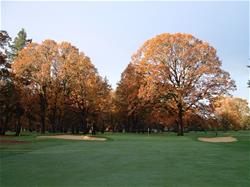Case Study: Royal Oaks Country Club, Oregon BMP Program
 Identifying the issue
Identifying the issue
Environmental compliance is necessary when operating a successful golf course operation. GCSAA member Alan Nielsen, CGCS at Royal Oaks Country Club in Vancouver, Wash., has faced various environmental laws and regulations that affected the management of the golf course. He chose to be proactive instead of reactive by developing a plan to comply with regulations in Washington state, particularly concerning critical wildlife habitat located at the course. Developing a written plan to present to environmental regulators helps to improve compliance and Royal Oaks’ ability to run its business effectively.
Planning a resolution
Nielsen and his team researched various methods of developing Best Management Practices (BMPs) for their course. Nielsen consulted the Oregon GCSA’s “Environmental Stewardship Guidelines” to successfully comply with regulations while concentrating on his specific management and business needs. It became his CliffsNotes version of how to create BMPs because of its simplicity and easily understood layout. Royal Oaks CC’s management plan included BMPs on cultural practices, fertilization, irrigation, pest management, wildlife management and pollution prevention practices.
Implementing solutions
Royal Oaks CC’s business model has always balanced the needs of the club, its members, and the community while maintaining efficient and nurturing relationships with the wildlife and its habitat. The facility has faced many challenges regarding habitat preservation and the maintenance of naturalized areas. To resolve this issue, Royal Oaks needed documentation to verify their environmental stewardship practices. Royal Oaks has implemented an Alternative Tree Management Plan (ATMP), an Integrated Pest Management Plan (IPM), and their own Royal Oaks BMP Plan based off the “Oregon Environmental Stewardship Guidelines”. These documents display compliance efforts and highlight their improvements in canopy coverage along Burnt Bridge Creek, increased implementation of naturalized vegetative areas, and overall golf maintenance operations. The “Oregon Environmental Stewardship Guidelines” offer a standardized format for documenting detailed BMP practices within the Pacific Northwest, and are designed to optimize environmental sustainability and protection.
Evaluation of results
The “Oregon Environmental Stewardship Guidelines” gave Nielsen and his course a roadmap to maintaining their golf course operations while enhancing land quality, preserving critical habitat for species such as the native Oregon White Oak, and saving time and money with reduced inputs after the implementation of native areas. The Oregon guidelines were developed by a committee of OGCSA members with guidance from a wide variety of resources including the Audubon Cooperative Sanctuary Program for Golf courses, the Oregon Pesticide Applicator Manual, and more. The guidelines were submitted to knowledgeable academic and regulatory resources for independent review and comment before the document was finalized. For Nielsen and Royal Oaks, following the “Oregon Environmental Stewardship Guidelines” has resulted in effective regulatory compliance and overall improvement in the business operation.